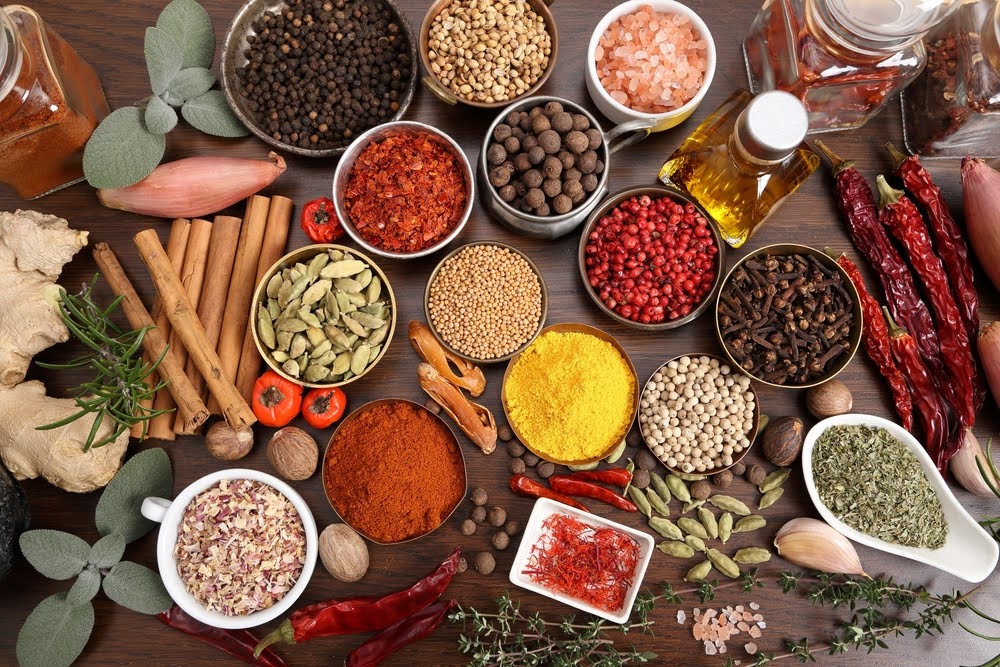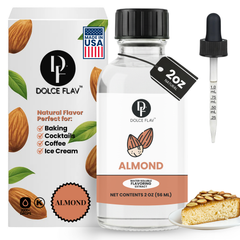
In cooking, whether you’re cooking on a range, baking delicious desserts, or even whipping together cocktails, there are two terms you’re going to hear nonstop.
Seasoning and flavoring.
When you think about it, those two sound like the same thing. After all, you add seasoning to dishes to add flavor, and flavoring products also introduce new flavors. So, it’s easy to see them both as the exact same concept.
However, there are some key differences that simply can’t be ignored, and if you’re going to take your cooking seriously, you should understand those differences fully.
Today, we’re going to compare the two in-depth, and then we’ll go over why it’s crucial to understand the difference. As well as some suggestions to help you boost your cooking game to all new levels.
Let’s get started.
What is Seasoning?
Seasoning is what most cooks use the most. Especially home cooks. You’re obviously familiar with items such as salt, pepper, various herbs, and other staple ingredients.
Have you ever thought about what those things actually do? If not, that’s the key point you’re missing on this topic.
Seasonings don’t actually make big changes to the food item being prepared. Instead, they elevate its natural flavor and bring out its true potential.
Take a good, high-quality, steak for example.
When you get a ribeye steak, you don’t cover it in sauce or inject it with cheesecake flavoring. Typically, you don’t add much more than salt, pepper, and a little butter for basting. Those items don’t make the steak taste like something else. They simply draw out the natural flavors and make them a bit more pronounced so you or the person you’re serving gets the most out of the experience.

This is the goal of seasoning. Yes, some seasonings do add different flavors or flavor profiles. However, they don’t completely change what the dish tastes like.
What is Food Flavoring?
Food flavoring is like seasoning. It’s used to enhance a dish. However, rather than enhancing what’s already there, it adds something entirely new. It completely changes the flavor profile for better or worse.
A good example of this would be a cheesecake imbued with raspberry flavoring.
There are no raspberries in the dish, and the cheesecake doesn’t taste anything like a raspberry. It’s creamy and milky with a lot of richness to it.
However, once the raspberry flavoring is added, the cheesecake now tastes like that flavoring with the texture of the cheesecake along with its sweetness.
Why is This Difference Important to Understand?
So far, it might seem like the difference is negligible, or as if we’re debating semantics, but there is a real reason to know the difference. In fact, there are several.
1: The Importance of Terminology
First and foremost, terminology is important in general. Whether you’re working in a kitchen and trying to relay information to other team members, or you’re at home trying to explain what you’re making the family for dinner, being able to communicate exactly what you’re doing is key to setting expectations or getting the right result.
If you’re just throwing terms around because they sound interchangeable when they’re not, you can create some confusing circumstances.
For example, let’s assume you’re a head chef in a kitchen, and you’re directing a teammate to make a lemon ice cream dish he hasn’t made before. You tell him to “season the ice cream with lemon”.
What you really want is for him to use lemon extract to make your new hit dessert item, but since you told him to season it, he zests a lemon on top of some vanilla ice cream, and you just have a weird, tangy, vanilla ice cream.
See, terminology matters.
2: Product Sourcing
Have you ever tried to search for “oregano flavoring” or “cheesecake seasoning”? Terminology is crucial when you’re attempting to source products. Whether that’s for a commercial kitchen or your personal home use.
Now, this is a minor reason that proper terminology is important, and the average person uses common sense, but it does help.
In fact, here’s a more complicated example.
What’s the difference between mint and mint flavoring?
Well, mint leaves, whether they’re dried and crushed or used fresh, are typically used to enhance a dish. They’ll be used on sweet or savory foods to enhance or help cut back on certain natural flavors in the dish. Mint flavoring is an oil infused with mint extract, and it goes throughout the entire dish. You’ll get two entirely different items that do entirely different things if you use the wrong terminology.
3: Using the Right Items for the Right Dish
Next, this is a reasoning we’ve already touched on a couple of times. You need to use the right option to achieve your intended culinary goal.
The best example of this would, once again, be mint. We’ll expand on our previous example.
Mint leaves can be used in quite a few savory dishes. They’re minty, but they’re not overpowering, and they can help cut back certain flavors that might be a little too overwhelming while adding a little to the flavor profile.
For example, several Thai dishes use mint leaves alongside very spicy meats. Spicy beef with mint leaves is a popular option. However, the meat isn’t turned into something reminiscent of a cough drop. It just pulls back the heat a little bit and adds a refreshing touch.
In contrast, mint flavoring, or mint extract, is extremely minty. It’s often infused with ice cream, sweets, and other dessert-oriented foods to add that refreshing mouthfeel it’s known for and enhance the flavors dramatically. It completely changes the dish’s flavor profile.

If you were to use mint flavoring in the same Thai spicy beef with mint, you would get a beef dish that tasted like toothpaste and burnt your mouth. That doesn’t sound very appealing, does it?
Obviously, a lot of flavoring options don’t have direct seasoning counterparts. So, there isn’t an abundance of situations like that, but it is important to know when to use the right methods to achieve a goal.
Using Seasoning Properly
Now that we talked about the differences and why it’s important, we want to go over some examples of how to use each one effectively. At Dolce Foglia, we obviously specialize in food flavorings and extracts, but both of these items are crucial for creating a diverse range of dishes whether they’re entrees, drinks, snacks, or desserts.
Seasoning is typically most appropriate when you’re working with something that has its own unique flavor profile that you want to preserve.
Steak is a great example of this that we talked about earlier. The profile of steak is addictive, and it’s one of those things that you want to preserve and enhance as much as possible. The fact that it’s expensive tends to make people stray away from changing its flavor profile, too. This is why the seasonings and added ingredients for a steak tend to be a lot simpler than they are with other meat dishes. Salt, pepper, and butter are the trio that are usually used, and other methods, such as dry aging, are used to enhance the natural flavor even further.
This is the perfect example of when to use seasoning over flavoring. When you want that natural flavor to come through on its own and shine, you season the item in a way that provides that.
It’s also notable that, in most situations where you’d used seasoning, flavorings are wildly inappropriate. Again, using steak, you wouldn’t want to use strawberry extract, flavor it like a cheesecake, or anything like that, because you’d ruin the flavor profile of the meat.
Using Flavoring Properly
Flavoring is usually the exact opposite. It tends to be used in two different types of dishes.
First, it can be used to improve the flavor of something that isn’t exactly enjoyable to most people. For example, very few people truly enjoy the taste of alcohol. They like the effects it has, and different garnishes and ingredients can be fun, but overall, few people like the taste of the alcohol itself.
Flavoring changes that. Instead of a vodka cocktail that is extremely harsh and has to be mixed with lots of other ingredients, such as cranberry juice, a couple of drops of extract can completely reinvent the way you see vodka. Instead of a dry, harsh, nostril-burning effect, you can enjoy a pineapple-flavored base ingredient mixed with cranberry juice for a complicated, yet enjoyable, drink.
Then, it can be used with more neutral flavor profiles to create something a little more complex.
Again, we’ll use vanilla ice cream as an example. It’s basic. People love it on its own, but there’s definitely a lot of room to work with it without missing its natural flavor. In fact, most ice creams you buy are essentially vanilla ice cream with flavoring added because of this.
With a few drops of whatever extract you enjoy, you can go from a basic vanilla ice cream to enjoying strawberry and cream, cheesecake, mango, or even birthday cake ice cream.

Flavoring works extremely well with more simplistic food items because the flavoring gets to come through a lot more without clashing with natural flavors.
One last time, we’ll look at steak. It has a complex natural flavor profile. If you marinate it in a mango extract for 30 minutes before you cook it, neither the natural flavors nor the mango flavoring are going to come through, and it’s a horrible experience. It’s already good on its own, and it’s complex.
What’s Better, Flavoring or Seasoning?
There’s no overall answer when comparing flavoring vs seasoning. If you’re cooking a large variety of dishes, both of these options are crucial. You need them in completely different situations, and having both truly opens up culinary possibilities. This isn’t one of those situations where you can rely on one over the other.
However, certain specialized cooks tend to benefit from one more than the other.
In a traditional kitchen cooking entrees, such as a standard restaurant, seasonings are probably going to be dominant. In a bakery or dessert-based establishment, flavorings are going to be a lot more useful than practically every seasoning besides salt.
Which one is better or deserves more space in your cupboard really depends on what you’re focusing your culinary efforts on.
The Common Theme for Both Options
Despite being used in entirely different situations, and producing entirely different effects, there are common themes for both options in terms of what you should be looking for and how you should be using them.
1: Quality is a Priority
First and foremost, the quality of either option is a top priority.
Whether you’re buying seasoning or flavorings, the quality of either item will affect the end result. You always want to source either item from a reliable and reputable source.
2: Portion Control is Everything
With both options, using the right amount is crucial to achieve a balanced flavor profile instead of an overwhelming mess. This is even more important with flavorings. While there’s room for you to tweak a recipe or accidentally add a little too much pepper to a dish, a flavoring is usually very concentrated. Not using an exact amount relative to the dish being served can be catastrophic.
Get the Highest Quality Flavorings at Dolce Foglia
When comparing flavoring vs seasoning, we can clearly see that flavorings are a little more complicated than seasonings. Most seasonings are naturally occurring and minimally processed. Whether you’re talking about salt, garlic powder, pepper, or whatever, it’s usually just that item dried, crushed, or otherwise formed into what you’re familiar with.
Extracts or flavorings are more like experiments in food science. Someone has to carefully craft them to create the flavor that the product is supposed to provide to your dish. As such, there’s a lot more that can go wrong, and you can easily get a low-quality product that tastes horrible if you don’t buy it from a reputable source.
Dolce Foglia specializes in offering only the finest food flavorings, with a large variety of options to choose from, and we’re your go-to source for your flavoring needs.
Check out our oil-soluble and water-soluble extracts and elevate your kitchen creations today!

